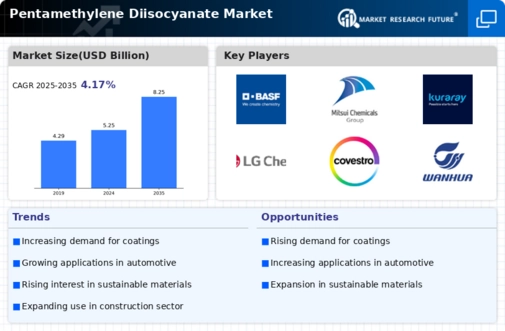Growth in Construction Activities
The Pentamethylene Diisocyanate Market is poised for growth, driven by an upsurge in construction activities across various regions. As urbanization accelerates and infrastructure projects gain momentum, the demand for high-performance materials is on the rise. Pentamethylene diisocyanate is increasingly utilized in the production of insulation materials, sealants, and coatings that are essential for modern construction. Market data suggests that the construction sector is a key consumer of pentamethylene diisocyanate, with projections indicating a steady increase in consumption as new building standards emerge. This trend underscores the importance of pentamethylene diisocyanate in meeting the demands of contemporary construction practices.
Expansion in the Automotive Sector
The automotive industry plays a pivotal role in the growth of the Pentamethylene Diisocyanate Market. With the increasing focus on lightweight materials and fuel efficiency, manufacturers are increasingly incorporating advanced polymers and coatings that utilize pentamethylene diisocyanate. This compound is favored for its ability to enhance the mechanical properties of automotive components, thereby improving overall vehicle performance. Recent market analyses indicate that the automotive sector is expected to witness a compound annual growth rate that significantly contributes to the overall demand for pentamethylene diisocyanate. As automotive manufacturers continue to innovate and adapt to consumer preferences, the relevance of pentamethylene diisocyanate in this sector is likely to expand.
Innovations in Product Development
Innovations in product development are significantly influencing the Pentamethylene Diisocyanate Market. Manufacturers are actively exploring new formulations and applications that leverage the unique properties of pentamethylene diisocyanate. This includes advancements in the production of flexible foams, elastomers, and coatings that cater to diverse industrial needs. The introduction of eco-friendly alternatives and enhanced performance characteristics is likely to attract a broader customer base. Market Research Future indicate that companies investing in research and development are better positioned to capitalize on emerging trends, thereby driving the overall growth of the pentamethylene diisocyanate market. This focus on innovation is expected to sustain interest and demand in the industry.
Rising Demand in Coatings and Adhesives
The Pentamethylene Diisocyanate Market is experiencing a notable surge in demand, particularly within the coatings and adhesives sector. This increase is largely attributed to the growing need for high-performance materials that offer durability and resistance to environmental factors. As industries such as automotive and construction prioritize quality and longevity, the adoption of pentamethylene diisocyanate in formulations is likely to rise. Market data indicates that the coatings segment alone is projected to account for a significant share of the overall market, driven by innovations in product formulations that enhance performance. This trend suggests a robust growth trajectory for the Pentamethylene Diisocyanate Market, as manufacturers seek to meet the evolving needs of end-users.
Regulatory Support for Advanced Materials
Regulatory support for advanced materials is emerging as a key driver for the Pentamethylene Diisocyanate Market. Governments and regulatory bodies are increasingly promoting the use of high-performance materials that meet stringent environmental and safety standards. This regulatory landscape encourages manufacturers to adopt pentamethylene diisocyanate in their product lines, as it aligns with sustainability goals and performance requirements. Market data suggests that compliance with these regulations not only enhances product credibility but also opens new avenues for market expansion. As the regulatory framework continues to evolve, the pentamethylene diisocyanate market is likely to benefit from increased adoption across various sectors.


















Leave a Comment